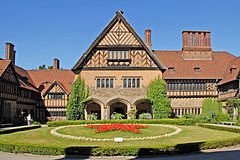Cecilienhof
| Cecilienhof Palace | |
|---|---|
| Schloss Cecilienhof | |

Cecilienhof Palace seen from the commemorative courtyard, with the Soviet red star in the foreground
|
|
|
Location of Schloss Cecilienhof in Germany
|
|
| General information | |
| Type | Palace |
| Architectural style | Tudor Revival |
| Town or city | Potsdam |
| Country | Germany |
| Coordinates | 52°25′09″N 13°04′15″E / 52.41917°N 13.07083°ECoordinates: 52°25′09″N 13°04′15″E / 52.41917°N 13.07083°E |
| Construction started | April 1914 |
| Completed | August 1917 |
| Cost | 1,498,000 Reichsmark |
| Client | Emperor Wilhelm II |
| Landlord | Stiftung Preussische Schlösser und Gärten |
| Design and construction | |
| Architect | Paul Schultze-Naumburg |
| Main contractor | Saalecker Werkstätten |
| Palaces and Parks of Potsdam and Berlin | |
|---|---|
| Name as inscribed on the World Heritage List | |
| Location | Germany |
| Type | Cultural |
| Criteria | i, ii, iv |
| Reference | 532 |
| UNESCO region | Europe and North America |
| Inscription history | |
| Inscription | 1990 (extended in 1992 and 1999) (14th Session) |
Cecilienhof Palace (German: Schloss Cecilienhof) is a palace in Potsdam, Brandenburg, Germany built from 1914 to 1917. Cecilienhof was the last palace built by the House of Hohenzollern that ruled the Kingdom of Prussia and the German Empire until the end of World War I. It is famous for having been the location of the Potsdam Conference in 1945, in which the leaders of the Soviet Union, the United Kingdom and the United States took important decisions affecting the shape of post World War II Europe and Asia. Cecilienhof has been part of the Palaces and Parks of Potsdam and Berlin UNESCO World Heritage Site since 1990.
Cecilienhof is located in the northern part of the large Neuer Garten park, close to the shore of the Jungfernsee lake. The park was laid out from 1787 at the behest of King Frederick William II of Prussia, modelled on the Wörlitz Park in Anhalt-Dessau. Frederick William II also had the Marmorpalais (Marble Palace) built within the Neuer Garten, the first Brandenburg palace in the Neoclassical style erected according to plans designed by Carl von Gontard and Carl Gotthard Langhans, which was finished in 1793. Other structures within the park close to Schloss Cecilienhof include an orangery, an artificial grotto (Muschelgrotte), the "Gothic Library", and the Dairy in the New Garden, also constructed for King Frederick William II.
...
Wikipedia

